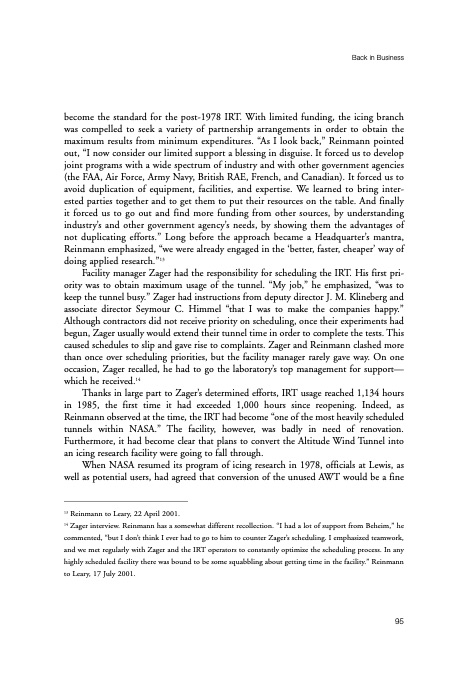
PDF Publication Title:
Text from PDF Page: 107
become the standard for the post-1978 IRT. With limited funding, the icing branch was compelled to seek a variety of partnership arrangements in order to obtain the maximum results from minimum expenditures. “As I look back,” Reinmann pointed out, “I now consider our limited support a blessing in disguise. It forced us to develop joint programs with a wide spectrum of industry and with other government agencies (the FAA, Air Force, Army Navy, British RAE, French, and Canadian). It forced us to avoid duplication of equipment, facilities, and expertise. We learned to bring inter- ested parties together and to get them to put their resources on the table. And finally it forced us to go out and find more funding from other sources, by understanding industry’s and other government agency’s needs, by showing them the advantages of not duplicating efforts.” Long before the approach became a Headquarter’s mantra, Reinmann emphasized, “we were already engaged in the ‘better, faster, cheaper’ way of doing applied research.”13 Facility manager Zager had the responsibility for scheduling the IRT. His first pri- ority was to obtain maximum usage of the tunnel. “My job,” he emphasized, “was to keep the tunnel busy.” Zager had instructions from deputy director J. M. Klineberg and associate director Seymour C. Himmel “that I was to make the companies happy.” Although contractors did not receive priority on scheduling, once their experiments had begun, Zager usually would extend their tunnel time in order to complete the tests. This caused schedules to slip and gave rise to complaints. Zager and Reinmann clashed more than once over scheduling priorities, but the facility manager rarely gave way. On one occasion, Zager recalled, he had to go the laboratory’s top management for support— which he received.14 Thanks in large part to Zager’s determined efforts, IRT usage reached 1,134 hours in 1985, the first time it had exceeded 1,000 hours since reopening. Indeed, as Reinmann observed at the time, the IRT had become “one of the most heavily scheduled tunnels within NASA.” The facility, however, was badly in need of renovation. Furthermore, it had become clear that plans to convert the Altitude Wind Tunnel into an icing research facility were going to fall through. When NASA resumed its program of icing research in 1978, officials at Lewis, as well as potential users, had agreed that conversion of the unused AWT would be a fine Back in Business 13 Reinmann to Leary, 22 April 2001. 14 Zager interview. Reinmann has a somewhat different recollection. “I had a lot of support from Beheim,” he commented, “but I don’t think I ever had to go to him to counter Zager’s scheduling. I emphasized teamwork, and we met regularly with Zager and the IRT operators to constantly optimize the scheduling process. In any highly scheduled facility there was bound to be some squabbling about getting time in the facility.” Reinmann to Leary, 17 July 2001. 95PDF Image | History of NASA Icing Research Tunnel

PDF Search Title:
History of NASA Icing Research TunnelOriginal File Name Searched:
sp4226.pdfDIY PDF Search: Google It | Yahoo | Bing
NFT (Non Fungible Token): Buy our tech, design, development or system NFT and become part of our tech NFT network... More Info
IT XR Project Redstone NFT Available for Sale: NFT for high tech turbine design with one part 3D printed counter-rotating energy turbine. Be part of the future with this NFT. Can be bought and sold but only one design NFT exists. Royalties go to the developer (Infinity) to keep enhancing design and applications... More Info
Infinity Turbine IT XR Project Redstone Design: NFT for sale... NFT for high tech turbine design with one part 3D printed counter-rotating energy turbine. Includes all rights to this turbine design, including license for Fluid Handling Block I and II for the turbine assembly and housing. The NFT includes the blueprints (cad/cam), revenue streams, and all future development of the IT XR Project Redstone... More Info
Infinity Turbine ROT Radial Outflow Turbine 24 Design and Worldwide Rights: NFT for sale... NFT for the ROT 24 energy turbine. Be part of the future with this NFT. This design can be bought and sold but only one design NFT exists. You may manufacture the unit, or get the revenues from its sale from Infinity Turbine. Royalties go to the developer (Infinity) to keep enhancing design and applications... More Info
Infinity Supercritical CO2 10 Liter Extractor Design and Worldwide Rights: The Infinity Supercritical 10L CO2 extractor is for botanical oil extraction, which is rich in terpenes and can produce shelf ready full spectrum oil. With over 5 years of development, this industry leader mature extractor machine has been sold since 2015 and is part of many profitable businesses. The process can also be used for electrowinning, e-waste recycling, and lithium battery recycling, gold mining electronic wastes, precious metals. CO2 can also be used in a reverse fuel cell with nafion to make a gas-to-liquids fuel, such as methanol, ethanol and butanol or ethylene. Supercritical CO2 has also been used for treating nafion to make it more effective catalyst. This NFT is for the purchase of worldwide rights which includes the design. More Info
NFT (Non Fungible Token): Buy our tech, design, development or system NFT and become part of our tech NFT network... More Info
Infinity Turbine Products: Special for this month, any plans are $10,000 for complete Cad/Cam blueprints. License is for one build. Try before you buy a production license. May pay by Bitcoin or other Crypto. Products Page... More Info
| CONTACT TEL: 608-238-6001 Email: greg@infinityturbine.com | RSS | AMP |